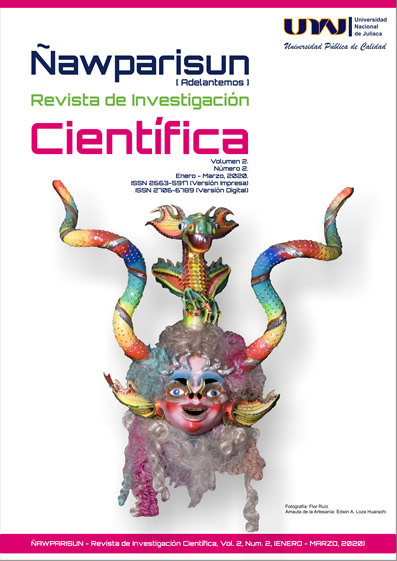Índice de radiación ultravioleta estimado por la Estación Meteorológica Davis de la Universidad Nacional de Juliaca
Resumen
El Índice UV (UVI) es medio por la estación meteorológica DAVIS VANTAGE PRO 2 PLUS de la Universidad Nacional de Juliaca, en el rango de 0-16, obteniendo datos de valores máximo diarios para el año 2018 considerando los tipos de cielos despejados, parcialmente despejados y nublados, de los cuales se observó que estos valores máximos mayores de 11 considerado extremo, se presentan en estación de verano. Para cada día los valores extremos de índice se presentan en el intervalo de tiempo de 10:30am a 14:30pm dependiendo del tipo cielo que se presente, observándose que los valores máximo se presentante al medio día solar para un tipo de cielo despejado, y que los valores disminuyen a medida que se alejan del medio día solar.Descargas
Citas
Allaart, M., van Weele, M., Fortuin, P., & Kelder, H. (2004). An empirical model to predict the UV-index based on solar zenith angles and total ozone. Meteorological Applications, 11(1), 59–65. https://doi.org/10.1017/S1350482703001130
Berger, D. S., & Urbach, F. (1982). A CLIMATOLOGY OF SUNBURNING ULTRAVIOLET RADIATION. Photochemistry and Photobiology, 35(2), 187–192. https://doi.org/10.1111/j.1751-1097.1982.tb03830.x
CEI. (1998). CIE S 007/E - Erythema Reference Action Spectrum and Standard Erythema Dose | Engineering360. Retrieved from https://standards.globalspec.com/std/365550/cie-s-007-e
Fabo, E. C. De, Noonan, F. P., Fears, T., & Merlino, G. (2004). Advances in Brief Ultraviolet B but not Ultraviolet A Radiation Initiates Melanoma. 6372–6376.
Fioletov, V. E., McArthur, L. J. B., Mathews, T. W., & Marrett, L. (2009). On the relationship between erythemal and vitamin D action spectrum weighted ultraviolet radiation. Journal of Photochemistry and Photobiology B: Biology, 95(1), 9–16. https://doi.org/10.1016/j.jphotobiol.2008.11.014
Gallagher, R. P., & Lee, T. K. (2006a). Adverse effects of ultraviolet radiation : A brief review. 92, 119–131. https://doi.org/10.1016/j.pbiomolbio.2006.02.011
Gallagher, R. P., & Lee, T. K. (2006b, September 1). Adverse effects of ultraviolet radiation: A brief review. Progress in Biophysics and Molecular Biology, Vol. 92, pp. 119–131. https://doi.org/10.1016/j.pbiomolbio.2006.02.011
Jacquet, S., & Bratbak, G. (2003). Effects of ultraviolet radiation on marine virusâphytoplankton interactions. FEMS Microbiology Ecology, 44(3), 279–289. https://doi.org/10.1016/S0168-6496(03)00075-8
Johnson, B. W., & Mcintyre, R. (1996). Analysis of test methods for UV durability polymer coatings. 27, 95–106.
Kunz, B. A., Cahill, D. M., Mohr, P. G., Osmond, M. J., & Vonarx, E. J. (2006, January 1). Plant Responses to UV Radiation and Links to Pathogen Resistance. International Review of Cytology, Vol. 255, pp. 1–40. https://doi.org/10.1016/S0074-7696(06)55001-6
Levels, U. R. (2017). fenotipos e infraestructura de protección solar en instituciones educativas de Piura , Perú Ultraviolet Radiation Levels , Phenotypes , and Infrastructure. 1621, 40–49.
Li, F., Peng, S., Chen, B., & Hou, Y. (2010). Acta Oecologica Original article A meta-analysis of the responses of woody and herbaceous plants to elevated ultraviolet-B radiation. Acta Oecologica, 36(1), 1–9. https://doi.org/10.1016/j.actao.2009.09.002
Liu, X., Hurren, C. J., & Wang, X. (1988). Compression Properties of Wool and Alpaca Fibres. (4).
Lonsberry, B. B., Wyles, E., Goodwin, D., Casser, L., & Lingel, N. (2008). Diseases of the Cornea. In Clinical Ocular Pharmacology (pp. 483–547). https://doi.org/10.1016/B978-0-7506-7576-5.50031-8
McKinley, A., & Diffey, B. (1987). A reference action spectrum for ultraviolet induced erythema in human skin. CIE, 6, 17±22.
Mouillet, V., Farcas, F., & Besson, S. (2008). Ageing by UV radiation of an elastomer modified bitumen. Fuel, 87(12), 2408–2419. https://doi.org/10.1016/j.fuel.2008.02.008
Norval, M. (2006). The Effect of Ultraviolet Radiation on Human Viral Infections. Photochemistry and Photobiology, 82(6), 1495–1504. https://doi.org/10.1111/j.1751-1097.2006.tb09805.x
Pahkala, M., Merilä, J., Ots, I., & Laurila, A. (2003). Effects of ultraviolet-B radiation on metamorphic traits in the common frog Rana temporaria. Journal of Zoology, 259(1), 57–62. https://doi.org/10.1017/S0952836902002984
Parker, S. G., & Diffey, B. L. (1982). The transmission of optical radiation through human nails. 11–16.
Roberts, J. E. (2001). Ocular photoxicity. Journal of Photochemistry and Photobiology B: Biology, 64(2–3), 136–143. https://doi.org/10.1016/S1011-1344(01)00196-8
Rozema, J., Björn, L. O., Bornman, J. F., Gaberščik, A., Häder, D. P., Trošt, T., … Meijkamp, B. B. (2002). The role of UV-B radiation in aquatic and terrestrial ecosystems-An experimental and functional analysis of the evolution of UV-absorbing compounds. Journal of Photochemistry and Photobiology B: Biology, 66(1), 2–12. https://doi.org/10.1016/S1011-1344(01)00269-X
Sinha, R. P., & Häder, D. P. (2002, April 1). UV-induced DNA damage and repair: A review. Photochemical and Photobiological Sciences, Vol. 1, pp. 225–236. https://doi.org/10.1039/b201230h
Sordo, C., & Gutiérrez, C. (2013a). Cáncer de piel y radiacion solar: Experiencia peruana en la prevencion y deteccion temprana del cáncer de piel y melanoma. Revista Peruana de Medicina Experimental y Salud Publica, 30(1), 113–117. https://doi.org/10.1590/S1726-46342013000100021
Sordo, C., & Gutiérrez, C. (2013b). Cáncer de piel y radiación solar: experiencia peruana en la prevención y detección temprana del cáncer de piel y melanoma. Revista Peruana de Medicina Experimental y Salud Pública, 30(1), 113–117. https://doi.org/10.1590/S1726-46342013000100021
Souza Correa, D., Suárez, H., & Salazar, G. (2015). Modelo de Madronich del Indice UV en Salta. Avances En Energías Renovables y Medio Ambiente, 19, 8–123. Retrieved from www.cmfotobiologia.com
Sweet, M., Kirkham, N., Bendall, M., Currey, L., Bythell, J., & Heupel, M. (2012). Evidence of melanoma in wild marine fish populations. PLoS ONE, 7(8). https://doi.org/10.1371/journal.pone.0041989
Tanskanen, A., Lindfors, A., Määttä, A., Krotkov, N., Herman, J., Kaurola, J., … Tamminen, J. (2007). Validation of daily erythemal doses from Ozone Monitoring Instrument with ground-based UV measurement data. Journal of Geophysical Research Atmospheres, 112(24), D24S44. https://doi.org/10.1029/2007JD008830
Urbach, F. (1989). POTENTIAL EFFECTS OF ALTERED SOLAR ULTRAVIOLET RADIATION ON HUMAN SKIN CANCER. Photochemistry and Photobiology, 50(4), 507–513. https://doi.org/10.1111/j.1751-1097.1989.tb05556.x
Verbeek, C. J. R., Hicks, T., & Langdon, A. (2011). Degradation as a result of UV radiation of bloodmeal-based thermoplastics. Polymer Degradation and Stability, 96(4), 515–522. https://doi.org/10.1016/j.polymdegradstab.2011.01.003
WMO. (2002). Retrieved from http://www.who.int/uv/
Zhang, L., Hartwell, L., Jr, A., Vaughan, M. M., Hauser, B. A., & Boote, K. J. (2014). Agricultural and Forest Meteorology Solar ultraviolet radiation exclusion increases soybean internode lengths and plant height. Agricultural and Forest Meteorology, 184(July 2011), 170–178. https://doi.org/10.1016/j.agrformet.2013.09.011




